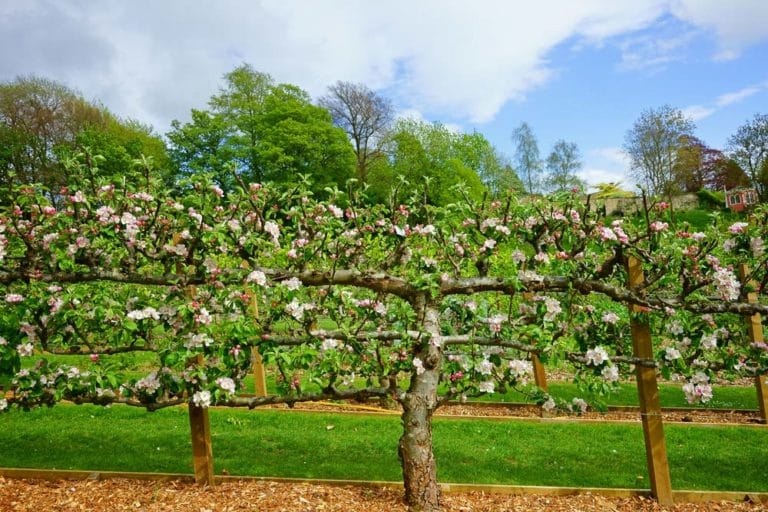
Espalier – part I
Training plants in formal patterns can increase food production, save space, and boost garden aesthetics in prairie climates.
- Patricia Hanbidge
August 17,2025
key points from this story:
- Espalier trains woody plants in 2D form
- Method dates back to medieval times
- Warmer microclimate speeds plant maturity
- Improves fruit production and picking ease
- Great for privacy or narrow spaces
- Best with dwarf apple or pear trees
Right now is a great time to evaluate your outdoor space to see if you can come up with some ideas to make it just a little bit more functional and unique to your personal preferences. Grab a tall, cool drink, find a comfortable place to sit and simply look and feel the ambiance of your space. Try not to be too critical but instead look around you from the perspective that you are new to your garden.
Generally, it seems that our outdoor spaces are hardly big enough to allow for all that you need it to be – especially if you like to produce food for your table. However, there is a unique way of pruning that will aid you in not only producing more food but with less space!
Espalier is a method of pruning that does not pay attention to the normal form of growth. It is the art of training woody plants to branch in more formal patterns along a wall, fence or trellis. It actually dates back to medieval times when the monks would grow fruit trees along the walls of the gardens to best utilize the limited space available. Growing these trees in a less natural two-dimensional form results in very little loss of growing area.
For us on the Prairies, there is yet another benefit. In areas of shorter growing seasons, the microclimate created along a wall or other inert structure can actually allow the plants to mature more quickly due to the added warmth these inert structures impart. South walls will warm earlier in spring, are warmer during the summer and will hold that heat further into the fall.
Particularly for fruit producing crops espalier will also allow for increased fruit production due to the excellent light that is allowed to penetrate all parts of the tree due to the open form of the structure. A spin off benefit is that the fruit is very easy to pick.
Use espalier to create privacy screens or to enhance those long, narrow areas we always seem to get stuck with in residential lots. Fencelines are also a great space for espalier as they can bring more interest to these property barriers. Ensure the spot has well-drained soil and at least 3 metres or linear space for the tree and its support system.
As you can see the benefits of espalier are great – so how exactly do you espalier? Believe it or not it is not difficult. Choose your first project to be an apple or pear which bears fruit on long-lived spurs (the tissue that actually bears the fruit). It is better to use a dwarfing rootstock to minimize the amount of pruning that will be necessary.
If you can, the best place to espalier is without a doubt a south-facing wall that receives full sun. If there is no shade during the winter, then you may have to create some shade to reduce the potential of sunscald. Remember that when choosing a site for espalier in the Northern hemisphere the angle of the sun will change with the season.
In order to get started you will first need to decide on the type of tree to espalier. Once that is done, a framework will need to be created that will support your beautiful creation. Wire is the traditional support which will need to be supported by the wall or fence. The easiest method is a series of eyebolts that support the design of choice. If you have chosen a site that does not have a fence or wall for support, properly placed, sturdy poles can be used. It is essential that the support structure is strong enough to support the growth of heavy branches and the fruit. It is typical that three levels of wire are used.
There are many different designs you can successfully use for espalier. Watch next week, for some specifics on design so you can enjoy espalier in your outdoor living space.
Last Mountain Times Newsletter
Join the newsletter to receive the latest updates in your inbox.


